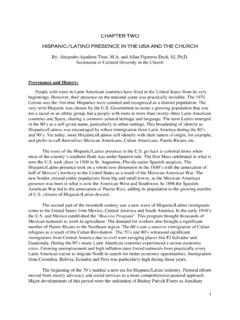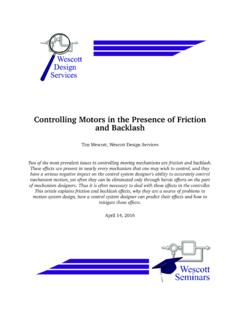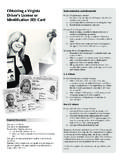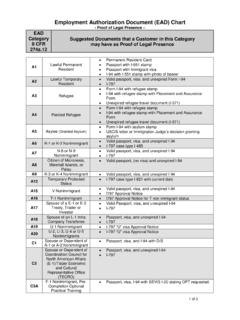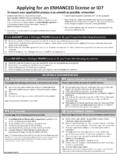Transcription of Pivot to the Pacific? The Obama Administration's ...
1 CRS Report for CongressPrepared for Members and Committees of Congress Pivot to the pacific ? The Obama Administration s Rebalancing Toward Asia Mark E. Manyin, Coordinator Specialist in Asian Affairs Stephen Daggett Specialist in Defense Policy and Budgets Ben Dolven Specialist in Asian Affairs Susan V. Lawrence Specialist in Asian Affairs Michael F. Martin Specialist in Asian Affairs Ronald O'Rourke Specialist in Naval Affairs Bruce Vaughn Specialist in Asian Affairs March 28, 2012 Congressional Research Service 7-5700 R42448 Pivot to the pacific ? The Obama Administration s Rebalancing Toward Asia Congressional Research Service Summary In the fall of 2011, the Obama Administration issued a series of announcements indicating that the United States would be expanding and intensifying its already significant role in the Asia- pacific , particularly in the southern part of the region.
2 The fundamental goal underpinning the shift is to devote more effort to influencing the development of the Asia- pacific s norms and rules, particularly as China emerges as an ever-more influential regional power. Given that one purpose of the Pivot or rebalancing toward the Asia- pacific is to deepen credibility in the region at a time of fiscal constraint, Congress s oversight and appropriations roles, as well as its approval authority over free trade agreements, will help determine to what extent the Administration s plans are implemented and how various trade-offs are managed. Areas of Continuity. Much of the Pivot to the Asia- pacific is a continuation and expansion of policies already undertaken by previous administrations, as well as earlier in President Obama s term.
3 Since President Obama s inauguration in 2009, the United States has given considerable time and emphasis to Southeast Asia and to regional multilateral institutions. Under President George W. Bush, the United States emphasized the strengthening of relations with existing allies in Asia, began moving toward a more flexible and sustainable troop presence in the region, concluded a free trade agreement (FTA) with South Korea, brought the United States into the Trans- pacific Partnership (TPP) FTA negotiations, and forged new partnerships with India and Vietnam. All of these steps have been furthered by the Obama Administration. Transformational Elements. That said, there are a number of new aspects of the shift. The most dramatic lie in the military sphere.
4 As part of a plan to expand the presence in the southwestern pacific and make it more flexible, the Obama Administration has announced new deployments or rotations of troops and equipment to Australia and Singapore. officials have also pledged that planned and future reductions in defense spending will not come at the expense of the Asia- pacific (nor of the Middle East). Additionally, underlying the Pivot is a broader geographic vision of the Asia- pacific region that includes the Indian Ocean and many of its coastal states. Benefits, Costs, and Risks. Underlying the Pivot is a conviction that the center of gravity for foreign policy, national security, and economic interests is being realigned and shifting towards Asia, and that strategy and priorities need to be adjusted accordingly.
5 For many observers, it is imperative that the United States give more emphasis to the Asia- pacific . Indeed, for years, many countries in the region have encouraged the United States to step up its activity to provide a balance to China s rising influence. There are a number of risks to the Pivot , however. In an era of constrained defense resources, an increased military emphasis on the Asia- pacific region might result in a reduction in military capacity in other parts of the world. Another budgetary consideration is that plans to restructure military deployments in Asia and minimize cuts in the Navy may run up against more restrictive funding constraints than plans yet assume. Additionally, the perception among many that the rebalancing is targeted against China could strengthen the hand of Chinese hard-liners.
6 Such an impression could also potentially make it more difficult for the United States to gain China s cooperation on a range of issues. Additionally, the prominence the Obama Administration has given to the initiative has raised the costs to the United States if it or successor administrations fail to follow through on public pledges made, particularly in the military realm. Pivot to the pacific ? The Obama Administration s Rebalancing Toward Asia Congressional Research Service Contents 1 What s Old and What s New? .. 2 Areas of Continuity ..2 Adjustments in Security Policy .. 4 A More Integrated, Region-Wide Approach to the Asia- pacific .. 5 A Broader Vision of the Region s 5 Congress Involvement in the Pivot .
7 6 Overall Benefits, Costs, and 6 The Rising Importance of the 6 The Pros and Cons of Becoming More Assertive with China .. 8 Opportunity Costs in Other Regions of the Globe .. 9 The Framing and Credibility of the Pivot .. 9 Military and Strategic Dimensions of The Pivot .. 10 Military and Strategic Costs, Benefits, and Other Considerations .. 12 Greater Priority to the Navy .. 12 Budgetary Pressures .. 13 Do the Strategy and Resources Match?.. 15 China s Military Modernization as a Driving Force Behind the Changes .. 15 Air-Sea Battle 16 Diplomatic Dimensions of the Pivot .. 16 Multilateral Diplomacy .. 17 Relations .. 18 Diplomatic Benefits and Risks .. 19 Economic Aspects of the Pivot .. 20 Asia s Regional Economic Integration.
8 21 The Importance of the TPP .. 22 The Role of China .. 23 Implications for Congress .. 24 Figures Figure 1. Map of the Asia- pacific .. 3 Figure A-1. Major Corridors for International 27 Ta b l e s Table 1. Regional Shares of Merchandise Trade .. 7 Table 2. Secretaries of State Visits to Foreign Countries by Region, Albright through Clinton .. 17 Table A-1. Regional Shares of Global Merchandise 26 Pivot to the pacific ? The Obama Administration s Rebalancing Toward Asia Congressional Research Service Appendixes Appendix A. The Economic Rise of Asia .. 26 Appendix B. Selected Documents and 28 Contacts Author Contact 29 Pivot to the pacific ? The Obama Administration s Rebalancing Toward Asia Congressional Research Service 1 Introduction1 In the fall of 2011 and early 2012, the Obama Administration announced that it would be intensifying the role in the Asia- pacific To do this, it intends to raise the region s priority in military planning, foreign policy, and economic policy.
9 With troops gone from Iraq and poised to be drawn down in Afghanistan, Administration officials say they plan to rebalance attention toward planning for future challenges and opportunities, such as those represented in the Asia- pacific region. As President Barack Obama stated in a November 2011 address to the Australian parliament, his goal is to ensure that the United States will play a larger and long-term role in shaping this region [the Asia- pacific ] and its future. 3 The ultimate goal, according to National Security Advisor Tom Donilon, is to promote interests by helping to shape the norms and rules of the Asia- pacific region, to ensure that international law and norms be respected, that commerce and freedom of navigation are not impeded, that emerging powers build trust with their neighbors, and that disagreements are resolved peacefully without threats or coercion.
10 4 As part of its proclaimed strategic turn toward Asia, since the fall of 2011 the United States has, among other steps: announced new troop deployments to Australia, new naval deployments to Singapore, and new areas for military cooperation with the Philippines; stated that, notwithstanding reductions in overall levels of defense spending, the military presence in East Asia will be strengthened and be made more broadly distributed, more flexible, and more politically sustainable ;5 released a new defense planning document that confirmed and offered a rationale for the rebalancing to Asia while retaining an emphasis on the Middle East; joined the East Asia Summit (EAS), one of the region s premier multinational organizations; and secured progress in negotiations to form a nine-nation Trans- pacific Strategic Economic Partnership (TPP) free trade agreement (FTA).











